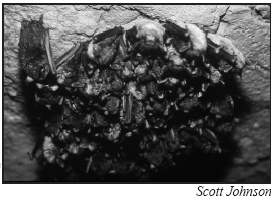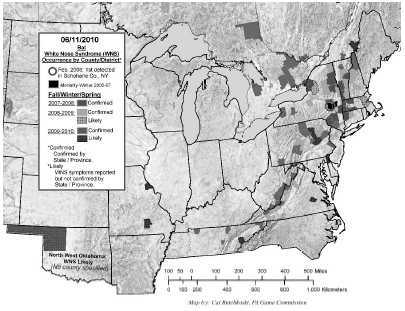Fall 2010 Volume 19 No. 3
Bats are Dying by the Thousands!
by Tim Carter
A new disease is hitting bats across the eastern United States. White-Nose Syndrome (WNS) as it is called is a poorly understood disease that has killed well over a million bats since its discovery in 2006. Biologists and scientists are still struggling to identify the exact cause of these mortalities. So far they have figured out that a newly discovered fungus is infecting bats while they are hibernating in winter. This fungus appears as a white fuzzy growth on the skin of the bats and is where the disease gets its name. However, while we suspect that the fungus is the actual cause of the deaths, we are still not certain if other agents are perhaps also involved – regardless, the outcome is bleak. When WNS hits a cave the hibernating bats within have little chance to survive. Because the bats are hibernating, much of their vital systems including their immune system are "turned off" to save energy. As the fungus attacks the bats they are forced to come out of hibernation and fire up their immune system to fight the infection. Since bats have limited energy reserves to make it through the winter, waking up to fight this fungal infection costs valuable energy reserves and the bats find themselves starving before spring and the insects they eat returns. Some history on WNS White-Nose Syndrome was first documented in New York State in 2006. In the 4 years since its discovery, the disease has moved west and south. Caves in Tennessee and Missouri have now tested positive for the disease. Generally it takes two years for the disease to take strong hold of a cave. In the first year we see some deaths, but mostly the early signs of the infection. But by the second year the bats are heavily infected and starve to death well before spring time. Data from the Northeast indicates about a 95% decline in bats over two years of the disease. As of yet, WNS has not been recorded from Indiana. But there is no reason to think that it will not find its way to Indiana strike our bats just as it has elsewhere. Why do we care? Bats are the primary night time insect control agent. Bats across the United States consume millions of pounds of insect each night. A single little brown bat can consume more than 1000 small insects each night! WNS is affecting all the cave bats in the eastern United States. Some models project the complete extinction of these cave bats in as few as 20-30 years, with dramatic population declines in as little as 5-10 years. Scientists still do not know what the effect on our ecosystem will be of loosing most of our night time insect control agents. Never in the recorded history of mankind have we seen the loss of an entire group of animals so quickly. Biologists are deeply concerned what the effects will be. What can we do?
For more information you can visit the White-Nose Syndrome web pages of the US Fish and Wildlife Service (http://www.fws.gov/whitenosesyndrome/). Across the country state and federal agencies are closing their caves to public access. We are doing this to slow the spread of this disease. It is strongly believed that while humans appear to be immune to this disease, we can certainly carry the fungal spores on our clothes and gear from cave to cave and speed up the spread of this disease. If you do go caving, biologists ask that you follow the decontamination procedures (on the USFWS web site above) to help prevent the spread of this disease. You may also donate to organizations that are directly funding the ongoing research to combat this disease.
Any good news?
To be honest the future looks bleak for bats. However, there is news that an anti-fungal drug may have been found that could help fight this disease. Even if this drug proves effective, there is still the challenge of applying this drug to the millions of bats that are still alive. Additionally, there are many other important fungi in the environment that play important and critical roles in the environment. Accidently killing these good fungi while killing the White-Nose fungus could have equally devastation effects on the environment. So while we are making progress toward a cure and treatment of this disease, much work is still need to save our bats. Tim Carter is an assistant professor of biology in the Department of Biology at Ball State University. His research interests include the ecology of bats in managed forest landscapes and Indiana bat conservation.
